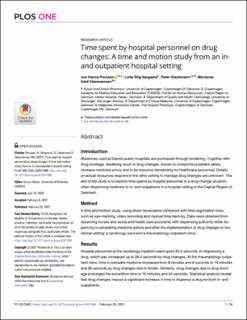| dc.contributor.author | Poulsen, Joo Hanne | |
| dc.contributor.author | Nørgaard, Lotte Stig | |
| dc.contributor.author | Dieckmann, Peter | |
| dc.contributor.author | Clemmensen, Marianne Hald | |
| dc.date.accessioned | 2022-01-27T08:13:18Z | |
| dc.date.available | 2022-01-27T08:13:18Z | |
| dc.date.created | 2022-01-26T15:58:44Z | |
| dc.date.issued | 2021 | |
| dc.identifier.citation | Poulsen, J. H., Nørgaard, L.S., Dieckmann, P., Clemmensen, M.H. (2021) Time spent by hospital personnel on drug changes: A time and motion study from an inand outpatient hospital setting. PLOS ONE, 16 (2). | en_US |
| dc.identifier.issn | 1932-6203 | |
| dc.identifier.uri | https://hdl.handle.net/11250/2877122 | |
| dc.description.abstract | Introduction
Medicines used at Danish public hospitals are purchased through tendering. Together with drug shortage, tendering result in drug changes, known to compromise patient safety, increase medicine errors and to be resource demanding for healthcare personnel. Details on actual resources required in the clinic setting to manage drug changes are unknown. The aim of the study is to explore time spend by hospital personnel in a drug change situation when dispensing medicine to in- and outpatients in a hospital setting in the Capital Region of Denmark.
Method
A time and motion study, using direct observation combined with time-registration tools, such as eye-tracking, video recording and manual time tracking. Data were obtained from observing nurses and social and health care assistants with dispensing authority while dispensing or extraditing medicine before and after the implementation of drug changes in two clinical setting; a cardiology ward and a rheumatology outpatient clinic.
Results
Hospital personnel at the cardiology inpatient ward spent 20.5 seconds on dispensing a drug, which was increased up to 28.4 seconds by drug changes. At the rheumatology outpatient clinic, time to extradite medicine increased from 8 minutes and 6 seconds to 15 minutes and 36 seconds by drug changes due to tender. Similarly, drug changes due to drug shortage prolonged the extradition time to 16 minutes and 54 seconds. Statistical analysis reveal that drug changes impose a significant increase in time to dispense a drug for both in- and outpatients.
Conclusion
Clinical hospital personnel spent significantly longer time on drug change situations in the dispensing of medicine to in- and outpatients in a hospitals. This study emphasizes that implementing drug changes do require extra time, thus, the hospital management should encounter this and ensure that additional time is available for the hospital personnel to ensure a safe drug dispensing process. | en_US |
| dc.language.iso | eng | en_US |
| dc.rights | Navngivelse 4.0 Internasjonal | * |
| dc.rights.uri | http://creativecommons.org/licenses/by/4.0/deed.no | * |
| dc.subject | medisinering | en_US |
| dc.subject | tidsbruk | en_US |
| dc.subject | sykehus | en_US |
| dc.title | Time spent by hospital personnel on drug changes: A time and motion study from an inand outpatient hospital setting | en_US |
| dc.type | Peer reviewed | en_US |
| dc.type | Journal article | en_US |
| dc.description.version | publishedVersion | en_US |
| dc.rights.holder | © 2021 Poulsen et al. | en_US |
| dc.subject.nsi | VDP::Medisinske Fag: 700::Klinisk medisinske fag: 750 | en_US |
| dc.source.pagenumber | 16 | en_US |
| dc.source.volume | 16 | en_US |
| dc.source.journal | PLOS ONE | en_US |
| dc.source.issue | 2 | en_US |
| dc.identifier.doi | 10.1371/journal.pone.0247499 | |
| dc.identifier.cristin | 1990673 | |
| cristin.ispublished | true | |
| cristin.fulltext | original | |
| cristin.qualitycode | 1 | |

